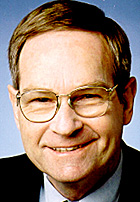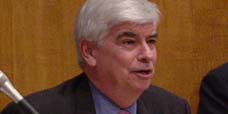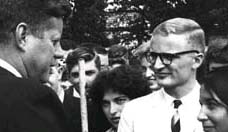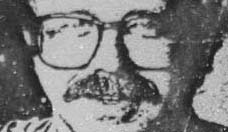2006.06.25: June 25, 2006: Headlines: Software: Technology: Engineering: Computers: Internet: Intel: RPCV Richard Wirt plies his trade as a software expert at a company known more for its hardware design savvy and multi-billion dollar fabrication facilities
Peace Corps Online:
Peace Corps News:
Library:
Peace Corps: Computers:
Computers:
2006.06.25: June 25, 2006: Headlines: Software: Technology: Engineering: Computers: Internet: Intel: RPCV Richard Wirt plies his trade as a software expert at a company known more for its hardware design savvy and multi-billion dollar fabrication facilities
RPCV Richard Wirt plies his trade as a software expert at a company known more for its hardware design savvy and multi-billion dollar fabrication facilities

"My organization, the Software and Solutions Groups, employs 2,500 software-focused employees, many of whom are Ph.D.-level engineers. We tune operating systems, including Linux and Microsoft Windows*, optimize .NET* and Java* managed runtime environments and communicate software-related concerns from independent software vendors and software developers at companies such as Goldman Sachs to the rest of Intel."
RPCV Richard Wirt plies his trade as a software expert at a company known more for its hardware design savvy and multi-billion dollar fabrication facilities
Software Technology Trends and Futures with Goldman Sachs Developers
Introduction
By Geoff Koch
[Excerpt]
What happens when Intel's top software developer visits Wall Street? The Intel Software Network excerpted highlights from Wirt's remarks to find out.
Intel’s Dr. Richard Wirt plies his trade as a software expert at a company known more for its hardware design savvy and multi-billion dollar fabrication facilities. An Intel Senior Fellow, corporate vice president and general manager of the Software and Solutions Group, Wirt’s job is making sure that the world’s software takes full benefit Intel’s newest platform features and technologies, including multi-core architecture. As an Intel Senior Fellow, he is also considered a top technical achiever within the company.
Most know Intel as the planet’s largest chipmaker whose silicon devices are plunked into servers, desktop PCs, laptops, handheld devices and networking gear. But the soft spoken Wirt, a University of Oklahoma mathematics Ph.D. who served in the Peace Corps in the sixties and taught math in the South Pacific Islands, seems to enjoy dropping startling snippets about the company’s software expertise.
“Bill Gates likes to beat us up about why we have a bigger compiler team than he does,” Wirt told a worldwide group of Goldman Sachs developers and technologists in a presentation earlier this year.
The 90-minute lecture and Q&A session covered the transition to 64-bit computing and multi-core processors, the lineup of Intel’s software development tools and the move to parallelism through threading and clustering. It also brought one of Intel’s leading technologists face to face with the tech team at one of the world’s leading investment banking, securities and investment management firms.
What happens when Intel’s top software developer visits Wall Street? The Intel Software Network excerpted highlights from Wirt’s remarks to find out.
How many software programmers work at Intel?
Around 10,000, though many of those work on Intel-specific projects such as running CAD machines or supporting all of our e-business customer initiatives. My organization, the Software and Solutions Groups, employs 2,500 software-focused employees, many of whom are Ph.D.-level engineers. We tune operating systems, including Linux and Microsoft Windows*, optimize .NET* and Java* managed runtime environments and communicate software-related concerns from independent software vendors and software developers at companies such as Goldman Sachs to the rest of Intel. We have programmers writing code at five or six sites around the world, while doing nightly builds and subjecting all of our software to a common testing regime. So we deal with many of the same integration and complexity issues as do many of the larger ISVs and corporate programming shops.
What’s happening in 64-bit computing at Intel?
In short, 64-bit computing is coming into all of our processors – top to bottom. It started with the Intel® Itanium® processor and Intel Itanium 2 processor for backend, mainframe computing environments. Itanium 2 -based servers continue to deliver world class performance. For example, NASA’s Columbia supercomputing system, composed of 20 interconnected SGI Altix* 512 Itanium 2-based systems, was recently ranked* the third most powerful supercomputer on the planet. We’re continuing to extend 64-bit computing across Intel desktop PC, server and workstation products.
Editor’s note: As of June 27, with the introduction of the Intel® Celeron® D processor 351, Intel now has Intel® Extended Memory 64 Technology (Intel® EM64T), or 64-bit memory addressability, available throughout its entire desktop and server processor lines.
Newer versions of Microsoft and Linux* operating systems are running 64-bit kernels. In these systems, it’s possible to vary between 32- and 64-bits on a per-process basis. Why Intel didn’t chose to port this model to its 64-bit chips?
Because of the complexity. To mix 32- and 64-bit processes, you often have to build a lot of custom scaffolding into an application stack. Interrupts are common, too, which cause problems by dumping 32-bit processes into the 64-bit kernel. Instead, with Intel EM64T , we chose simply to think a 32-bit process as it goes into the kernel. This stretches the parameters from 32- to 64-bits going into the kernel. The parameters are truncated back to 32-bits on their way out. The WOW subsystem (described in this MSDN*) handles this stretching and truncating behind the scenes, thus making it easier for developers.
How is Intel helping developers transition to 64-bit computing?
By investing significantly in tools. We offer software development products for C, C++ and FORTRAN developers working on 64-bit projects. Our tools support Windows and Linux and span architectures, from the Itanium processor family, to all of our 32-bit chips utilizing Intel EM64T down through the Intel XScale® Technology, which powers PDAs and smart phones. Our tools make it easier to move between environments and across architectures.
What’s more significant for developers – the move to 64-bit computing or to multi-core architecture?
The move to multi-core. Moving to 64-bits just entails cleaning up your code and then recompiling. But to take advantage of multi-core architectures, you have to make some decisions about threading.
[Excerpt]
Are you worried about the end of Moore’s Law?
No. We’ll be able to decrease feature size on our chips for at least 15 years. Design and fabrication changes, such as moving from 2D to 3D transistors, may extend things beyond that. Even when we reach hard and fast physical limits we’ll still be able to deliver the benefits of Moore’s Law – more computing power at a lower price – by increasing the number of processing cores on our CPUs. These benefits will continue to ship from our factories for the duration of my career at Intel. This also goes for the careers of most of the people who today work for me in the Software and Solutions Group, including those fresh out of college.
Intel Senior Fellow Richard Wirt is vice president and general manager of Intel’s Software and Solutions Group.
When this story was posted in July 2006, this was on the front page of PCOL:





Peace Corps Online The Independent News Forum serving Returned Peace Corps Volunteers
 | Jody Olsen is acting Peace Corps Director
The Senate confirmed Gaddi Vasquez to head the FAO on June 30. Jody Olsen will be acting Director until the President makes a permanent appointment. Olsen has been Deputy Director of the Peace Corps since 2002. She has previously served as Chief of Staff for two directors, as regional director for North Africa, Near East, and Asia and the Pacific, and as country director in Togo. She served in Tunisia as a PCV. |
 | The Peace Corps Library
The Peace Corps Library is now available online with over 40,000 index entries in 500 categories. Looking for a Returned Volunteer? Check our RPCV Directory. New: Sign up to receive PCOL Magazine, our free Monthly Magazine by email. Like to keep up with Peace Corps news as it happens? Sign up to recieve a daily summary of Peace Corps stories from around the world. |
 | Changing the Face of Hunger
In his new book, Former Congressman Tony Hall (RPCV Thailand) says humanitarian aid is the most potent weapon the United States can deploy against terrorism. An evangelical Christian, he is a big believer in faith-based organizations in the fight against hunger. Members of Congress have recently recommended that Hall be appointed special envoy to Sudan to focus on ending the genocide in Darfur. |
 | PC will not return to East Timor in 2006
Volunteers serving in East Timor have safely left the country as a result of the recent civil unrest and government instability. Latest: The Peace Corps has informed us that at this time, the Peace Corps has no plans to re-enter the country in 2006. The Peace Corps recently sent a letter offering eligible volunteers the opportunity to reinstate their service in another country. |
 | Chris Dodd considers run for the White House
Senator Chris Dodd plans to spend the next six to eight months raising money and reaching out to Democrats around the country to gauge his viability as a candidate. Just how far Dodd can go depends largely on his ability to reach Democrats looking for an alternative to Hillary Clinton. PCOL Comment: Dodd served as a Volunteer in the Dominican Republic and has been one of the strongest supporters of the Peace Corps in Congress. |
 | Vasquez testifies before Senate Committee
Director Vasquez testifies before the Senate Foreign Relations Committee on his nomination as the new Representative to the United Nations Agencies for Food and Agriculture replacing Tony Hall. He has been the third longest serving Peace Corps Director after Loret Ruppe Miller and Sargent Shriver. PCOL Comment: Read our thanks to Director Vasquez for his service to the Peace Corps. |
 | Interview with a Hit Man
RPCV John Perkins says that for many years he was an "economic hit man" in the world of international finance whose primary job was to convince less developed countries to accept multibillion dollar loans for infrastructure projects that left the recipient countries wallowing in debt and highly vulnerable to outside political and commercial interests. In this exclusive interview for "Peace Corps Online," Colombia RPCV Joanne Roll, author of Remember with Honor, talks to Perkins about his Peace Corps service, his relation with the NSA, "colonization" in Ecuador, the consequences of his work, why he decided to speak out, and what his hopes are for change. |
 | Peace Corps stonewalls on FOIA request
The Ashland Daily Tidings reports that Peace Corps has blocked their request for information on the Volkart case. "After the Tidings requested information pertaining to why Volkart was denied the position — on March 2 — the newspaper received a letter from the Peace Corps FOIA officer stating the requested information was protected under an exemption of the act." The Dayton Daily News had similar problems with FOIA requests for their award winning series on Volunteer Safety and Security. |
 | PCOL readership increases 100%
Monthly readership on "Peace Corps Online" has increased in the past twelve months to 350,000 visitors - over eleven thousand every day - a 100% increase since this time last year. Thanks again, RPCVs and Friends of the Peace Corps, for making PCOL your source of information for the Peace Corps community. And thanks for supporting the Peace Corps Library and History of the Peace Corps. Stay tuned, the best is yet to come. |
 | History of the Peace Corps
PCOL is proud to announce that Phase One of the "History of the Peace Corps" is now available online. This installment includes over 5,000 pages of primary source documents from the archives of the Peace Corps including every issue of "Peace Corps News," "Peace Corps Times," "Peace Corps Volunteer," "Action Update," and every annual report of the Peace Corps to Congress since 1961. "Ask Not" is an ongoing project. Read how you can help. |
 | RPCV admits to abuse while in Peace Corps
Timothy Ronald Obert has pleaded guilty to sexually abusing a minor in Costa Rica while serving there as a Peace Corps volunteer. "The Peace Corps has a zero tolerance policy for misconduct that violates the law or standards of conduct established by the Peace Corps," said Peace Corps Director Gaddi H. Vasquez. Could inadequate screening have been partly to blame? Mr. Obert's resume, which he had submitted to the Peace Corps in support of his application to become a Peace Corps Volunteer, showed that he had repeatedly sought and obtained positions working with underprivileged children. Read what RPCVs have to say about this case. |
 | Why blurring the lines puts PCVs in danger
When the National Call to Service legislation was amended to include Peace Corps in December of 2002, this country had not yet invaded Iraq and was not in prolonged military engagement in the Middle East, as it is now. Read the story of how one volunteer spent three years in captivity from 1976 to 1980 as the hostage of a insurrection group in Colombia in Joanne Marie Roll's op-ed on why this legislation may put soldier/PCVs in the same kind of danger. Latest: Read the ongoing dialog on the subject. |
Read the stories and leave your comments.

Some postings on Peace Corps Online are provided to the individual members of this group without permission of the copyright owner for the non-profit purposes of criticism, comment, education, scholarship, and research under the "Fair Use" provisions of U.S. Government copyright laws and they may not be distributed further without permission of the copyright owner. Peace Corps Online does not vouch for the accuracy of the content of the postings, which is the sole responsibility of the copyright holder.
Story Source: Intel
This story has been posted in the following forums: : Headlines; Software; Technology; Engineering; Computers; Internet
PCOL33219
51






















